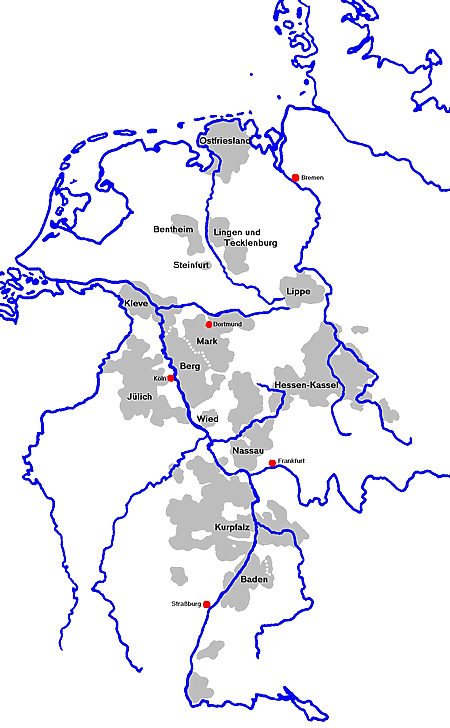In Lessons 2 and 3 of
the basic course, the beginnings of the Reformed Reformation in Switzerland
and Geneva were discussed (with a brief look at France).
This lesson shall deal with the question of how the Reformation of Reformed character
became established in individual parts of Germany. It will be seen that this
was not a uniform occurrence. For one, there was the phenomenon that individual
regions, which had turned in the first place to the Lutheran Reformation, became
Reformed in the course of the sixteenth Century, e.g. the counties of Bentheim
and Lippe or the Electoral Palatinate. Besides this, there were also regions
that experienced a reformation of a Reformed character from the beginning, e.g.
Upper Germany, or that initially existed as much under Lutheran as Reformed influence,
e.g. the Palatinate. And there were in Germany numerous congregations of refugees
(above all Huguenots and Waldenses). All this makes it difficult to grasp the
entire occurrence in one concept. The suggestion, discussed a great deal around
1985, to name the whole occurrence a “second Reformation” after a
first Lutheran Reformation, must be viewed as a failure. For it makes into a
rule a sequence which was present in only some areas, of first Lutheran and then
Reformed confessionalisation. It is therefore more fitting, with regard to Germany,
to speak somewhat more diffusely of the “Reformed confessionalisation” and
the history of Reformed churches and congregations in the sixteenth and seventeenth
centuries. Therefore, because of the very different ways in which the Reformed
congregations originated in Germany, there are relatively many sections in this
lesson standing independently of each other. They reflect the diversity but also
demonstrate the complexity of the historical developments.
The Reformed church was first officially acknowledged in Germany in 1648 by the
Peace Treaty of Westphalia in Munster and Osnabrueck, which ended the Thirty
Years’ War. Before this, there was an important event in the year of 1555.
In the Religious Peace Treaty of Augsburg, two decisions were reached among others.
For one, general peace was guaranteed for the members of the Augsburg Confession.
For another, the so-called “ius reformandi” was confirmed. As a result,
the regional rulers, counts and estates could determine the confession of their
country (which later arrived at the formula “cuius regio eius religio” – “he
to whom the region belongs defines also the religion”). The fact that the
Reformed confession was related to the Augsburg Confession gave the regional
rulers who were becoming Reformed the freedom to introduce it into their areas.
For the Reformed confession, confessionalisation reached from 1563 (when the
Electoral Palatinate became Reformed) to the Peace Treaty of Westphalia in 1648.
There, on the one hand, the same right was granted to the Reformed as to the
Catholics and Lutherans. And on the other hand, the “ius reformandi” was
limited so that a change of confession of the regional ruler no longer had to
be followed by that of his region.
